The first time I ever heard of the John Day River in Oregon was back in 1987, when I won the first of state Nevada Trout Stamp contest. I had to go to a sports show in Reno to sign prints of the design, and the booth across from where I was signing at the show had a large mounted smallmouth hanging on the wall. So naturally I went over and talked to the people there. They were running trips on this river in Oregon that was full of smallmouth. Well, I was interested. Their photos of the scenery was nothing like what I'd pictured rivers in Oregon to be like, but what really turned me on was that they said they were the only outfit running guided trips on the river during the low water of mid- to late-summer, and in a five day trip we would never see another person. So I traded a painting for a trip for me and Mary.
That trip, in 1988, was epic. There were six other clients besides Mary and me, but all but one of the others were not serious anglers. It wouldn't have mattered. We all caught smallmouth until our hands were chewed nearly to ribbons from lipping and unhooking fish. They came in all sizes. The majority were under 12 inches, but there were plenty of 14-16 inchers and enough 17 to 20 inchers to keep us fishing like crazy trying to catch more of them. I counted the number of fish I caught on my second best day of the five days we were on the river, and ended up with 175 smallmouth that day. I probably caught at least 20 that were over 17 inches, topped by a couple 20s and a huge 21 incher. And the scenery was simply spectacular. The guides told us we'd never see but one sign of civilization, the roof of a shed that was atop the plateau, miles away, but could be seen briefly if you looked up a side canyon. They were right. They weren't right about everything...they told us not to worry about a tent because it never rained during the summer, but on our fourth night a huge thunderstorm struck and the 11 of us spent hours huddled under a 12 by 20 foot tarp, wind howling and trying to blow our shelter away. Just one more facet of the story of that trip.
Naturally I had to go back. Our second trip was a few years later with another couple, artist friends of ours, on a section farther upstream that wasn't quite as wild or scenic but was still pretty spectacular, as was the fishing. Then in August of 1999, I did another trip on the lower wilderness section, this time with a different company, accompanied by cwc on here and two other Missouri anglers. This time, the fishing was disappointing. There had been a huge landslide farther up the river just prior to our trip, and the river was still working its way through the debris, fluctuating in flow and remaining very murky. We only averaged about 25 fish a day because of those conditions.
After that, the river went on the back burner...still a stream I'd like to return to someday but not a priority.
But then I met Dirty Ed on the Riversmallies website, and fished with him and his two friends, Doug and John. Dirty Ed's real name is Ken, and the three of them are from Ohio. I don't know who first mentioned the John Day, but Ken really wanted to fish it, and I started getting excited to go back. We tentatively set up a do-it-yourself trip for last summer. But other things got in the way and I couldn't go, and besides, the river was extremely low by early July, so Ken and the others opted out as well. But we were bound and determined to do it this summer.
It started out being a canoe trip. The kind of watercraft you use on the John Day is somewhat dependent upon water level. If it's flowing under 500 cfs, canoes and kayaks make the most sense, and typically by mid-July it's down below that mark. When I had floated it before, it had been down around 300-400 cfs, and the first two trips we had used inflatable one person kayaks, while the guides carried all the camping and food gear in smallish rafts. The third trip, we'd floated in one person pontoons propelled by kayak paddles, with again the guides using small rafts. So obviously the river was doable at that level in rafts, though they weren't recommended below that 500 cfs mark. And the fly in the ointment was that, because we were doing a DIY trip, we wouldn't be able to use the private access the guides used, which not only cut 14 miles off the trip but also was below the one true hazard, Clarno Rapids. Clarno Rapids is rated class 3 and 4, and would either be dangerous to kayaks and canoes at flows above 500 cfs, or nearly impassible in rafts below 400 cfs, or so the guide books said. So we watched river flows religiously as the time approached. It looked for a long time like the flow would be right around that 500 cfs mark by the time of out trip; the river had been a little above normal all early summer, and though it was dropping steadily, the snow pack in the mountains at its headwaters was still substantial. So by the time we absolutely had to make a decision on what kind of boats to use, it seemed rafts would be in order, and that's what we would end up taking.
Then the river started dropping much faster, and by the time of the trip, it was down below 400 cfs, and we were pretty nervous about Clarno Rapid. Would we be able to make it in rafts? Two more of my Montana buddies were going to go, and we planned to take three rafts. John would row solo in a smallish raft and carry a good portion of the gear. Ken and Doug would be in a smallish raft, and my two buddies and I would be in my bigger raft. But at nearly the last minute, my buddies had to cancel. Now I had to make a big choice...take the big raft by myself? Or could I do it in my one person Water Master raft? I decided to take the Water Master.
You have to get permits to float the John Day, which is both an Oregon scenic river and a National Wild and Scenic river, though there is no limit (so far) on the number of people floating it. We got the permits, and the Ohio boys drove out and met me at our Montana house. The next morning we piled all my stuff, including the folded up Water Master, in their big Dodge truck along with all their stuff, and drove the 10 hours to Arlington OR, where we spent the night. The next morning we drove to Fossil, dropped off a set of keys with the guy who would shuttle our vehicle the 70 miles from put-in to take-out, and headed for the river at Clarno. Our first view was both promising and worrisome--the riffle near the bridge didn't look very big, but there were small smallmouth swimming all around the sandy ramp to the water as we unloaded, inflated the rafts, and loaded all the gear. After more than an hour in 90 degree sunshine, we started down the river, through that first riffle where we at least never touched bottom, and we were committed to 70 miles and 6-7 days of wild river.
We were so worried about Clarno Rapid, 5 miles downstream, that we didn't even rig fishing rods, we just steadily rowed. The riffles were easy at first, but a mile above Clarno Rapids we encountered the first thing I was worried about, shallow riffles over a mostly solid basalt bottom. I'd been worried mainly that the basalt would be sharp and might damage the rafts, but we slid over the shallows with relative ease.
Clarno is actually two rapids, an upper and a lower. We finally came to Upper Clarno. We got out to scout it, and it had an impressive three or four foot drop through big boulders, but looked easily doable in the center gap. 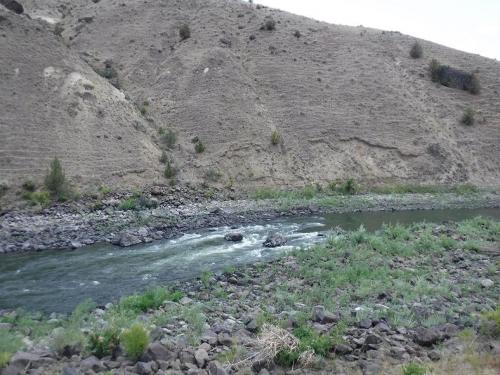
No problem. I ran it easily even in the little Water Master. Then, a quarter mile downstream, the river split at a rocky island, with most of the water going over a shallow rock riffle with about two feet of drop...and then we were at the head of Lower Clarno. We climbed up the hill to scan it, and it didn't look good. It was a boiling obstacle course.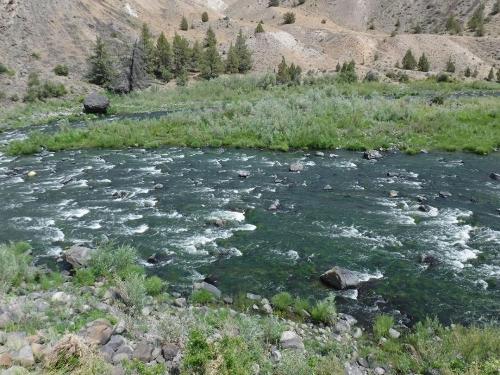
Which went a long way before funneling down a bit to the last big drop, about three feet through the jagged teeth of a row of huge boulders.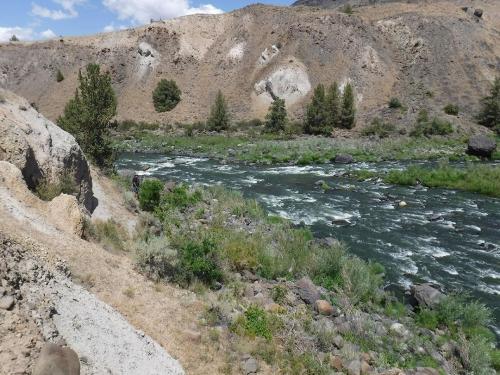
Viewed from below, you could see that final drop, with the only option the gap on far river left, which is to the right in this photo. 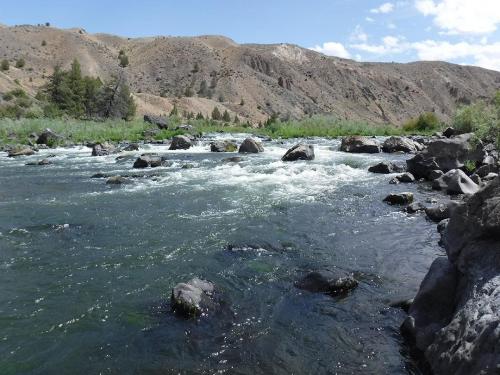
The problem with that option was the huge boulders guarding it just upstream, which you had to slide behind to line up for that drop. And then there were two barely submerged boulders just 10 feet above the drop, and there was really no way to avoid both...you'd have to slide over one of them. And finally there were other boulders barely underwater just below the drop. But there was nothing to do but run it. I took off first, finding it surprisingly easy to negotiate the obstacle course of the rapid until I neared that drop. I slid into position, and saw I could hit the gap easily, but the roiling, boulder strewn water at the bottom of the drop looked even scarier from river level. I'm sorry to say I chickened out. I eased over to the bank and the other guys, who were there watching, helped me slide the loaded Water Master over the rocks behind the big boulder on the edge of the bank. Then I ran the last bit of froth below.
The other guys all have a lot of whitewater experience, but Ken wasn't feeling well. John was next, and he made it down the rock garden, slid into the gap perfectly, over the submerged guard rocks, though the gap barely wider than his raft, and rode out the waves below. Ken then asked him to take the other raft down. He did, even better. We were past Clarno!

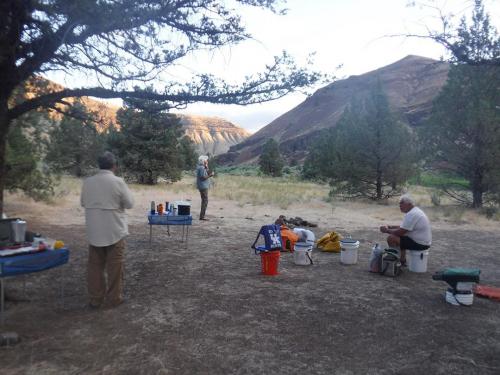
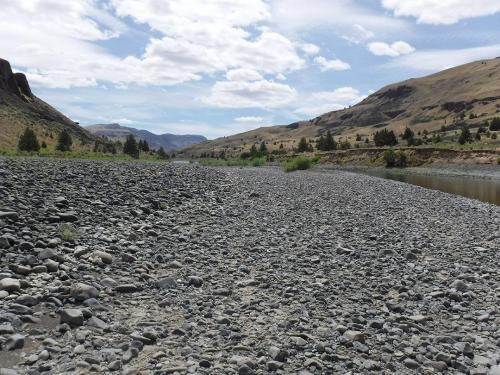
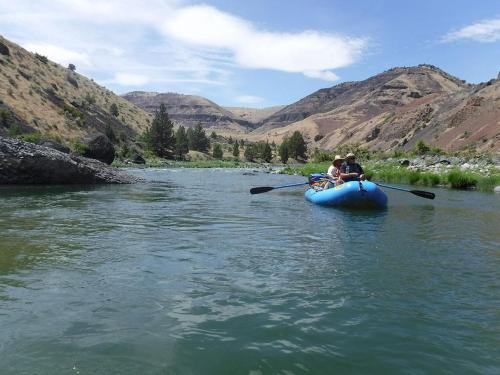
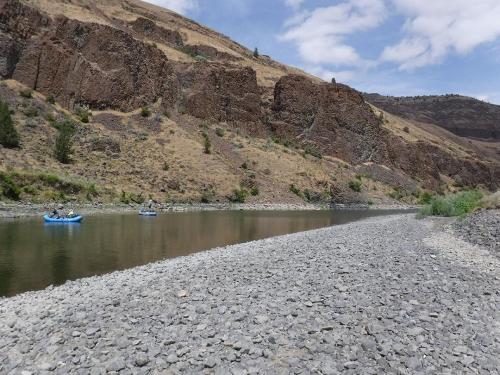
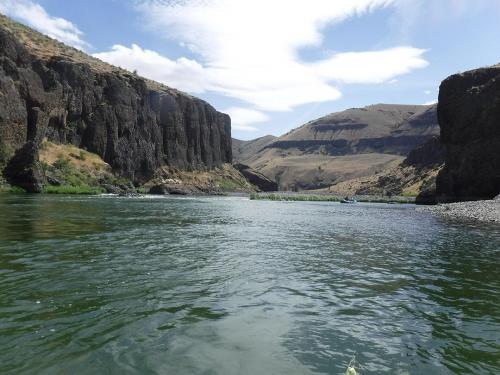
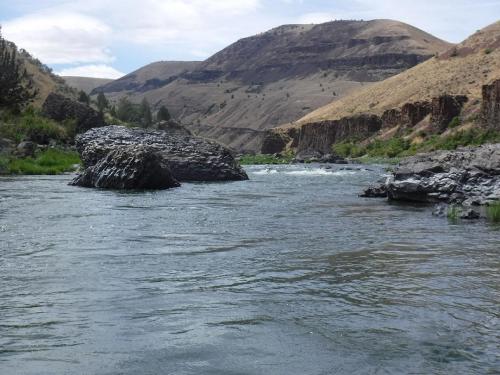
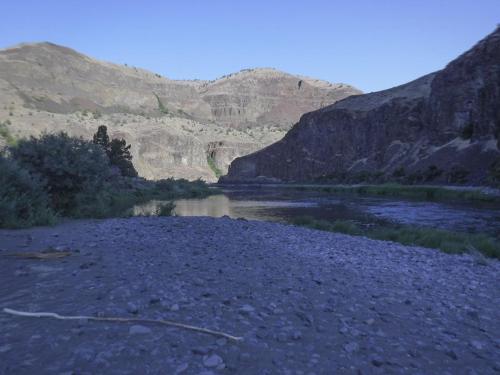

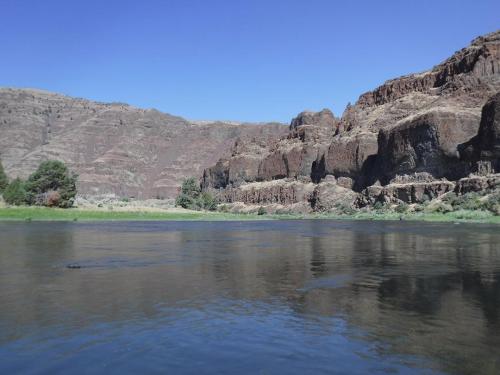
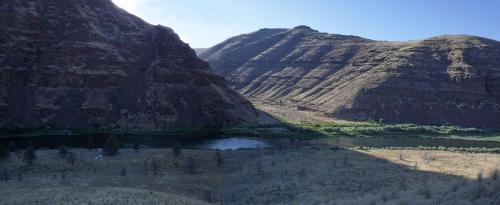
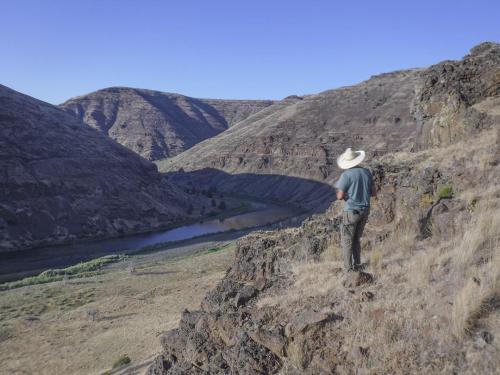
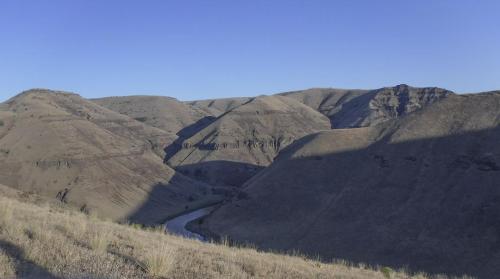
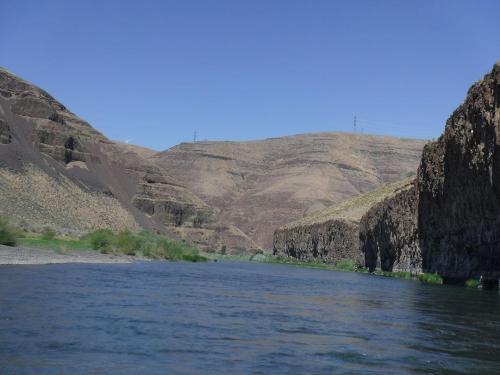
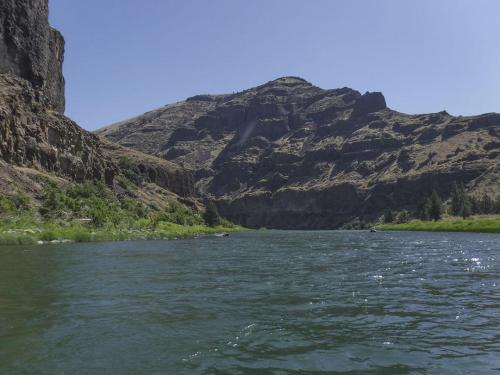
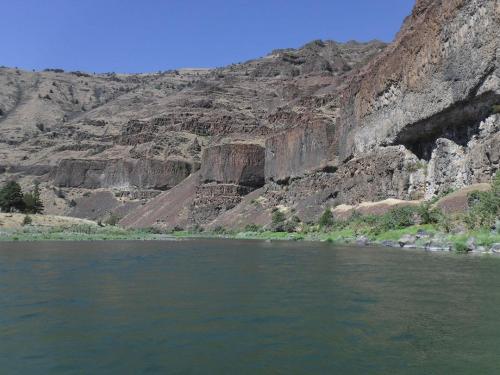
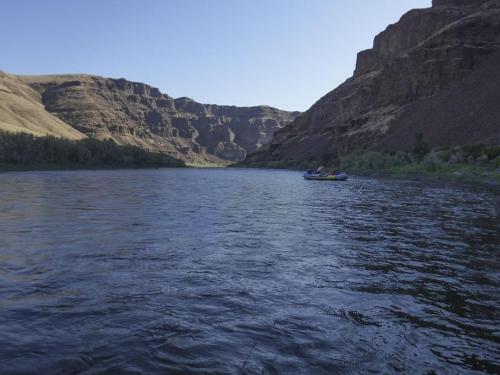
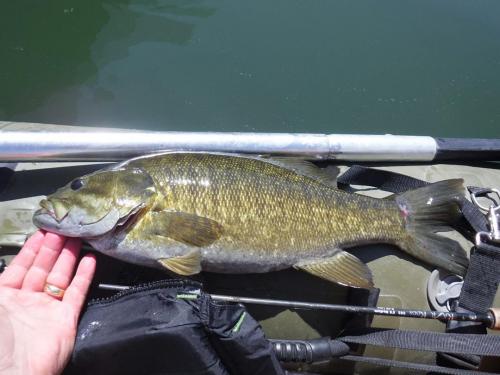
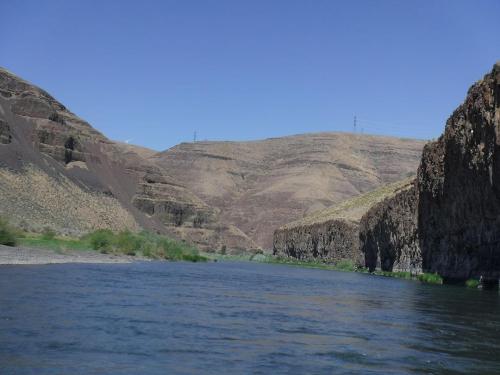


No comments:
Post a Comment